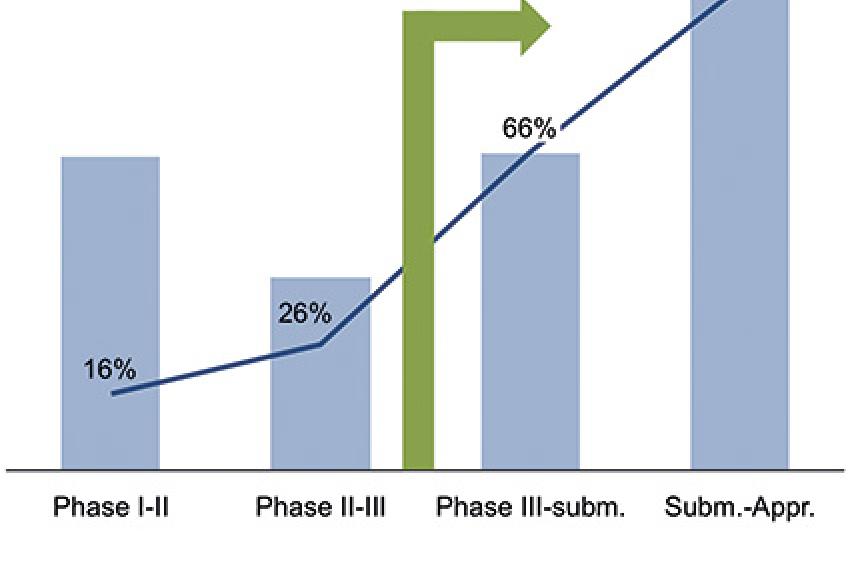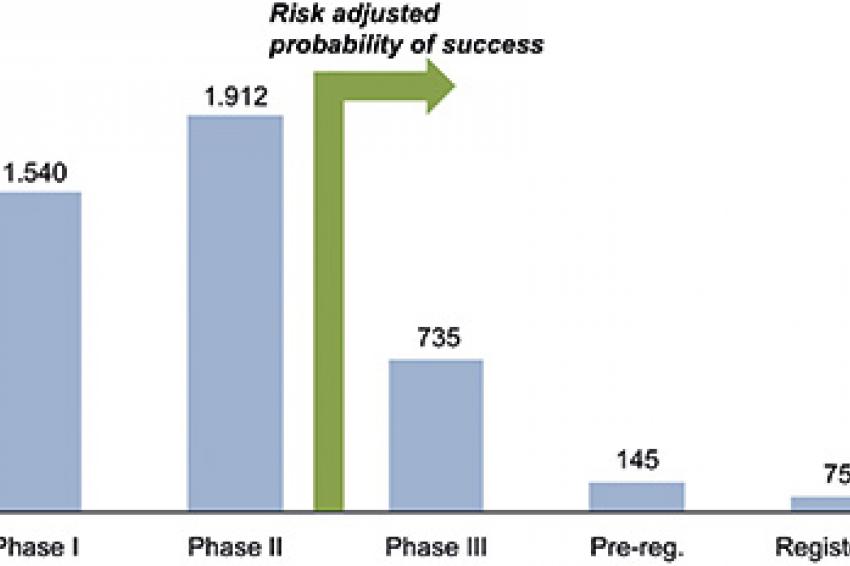Double Risk with an Upgrade
Business Development Landscape in Pharmaceutical Contract Manufacturing
Trial And Error - Despite a 150-year history and an aggregate R&D expenditure of $150 billion per year, innovation in the modern pharmaceutical industry is essentially still based on trial and error. Only 1 out of 5,000-10,000 investigated molecules will eventually be approved by regulatory authorities.
In total, fewer than 30 new medicines based on new molecular entities have been launched per year over the past 10 years. Moreover, during this period, one third of the new drug substances were high molecular weight molecules made by mammalian cell technology, which is accessible only to a small number of fine chemical companies. In the future, the share of biopharmaceuticals is expected to increase further.
The relationship between the pharma and the fine chemical industries is challenging. On the one hand, pharma is the major customer segment, accounting for almost two-thirds of the $85 billion fine chemicals market. On the other hand, the high attrition rate of the pharma R&D is such that the reservoir of attractive new product opportunities is small. The situation is exacerbated by the fact that the fine chemical industry is plagued with overcapacity and desperately needs to rejuvenate and expand its aging product portfolio.
With a total size of 10,452 R&D projects in the pharma pipeline, the reservoir of opportunities for new business appears enormous - at first glance. Nonetheless, reality is different when taking into account the high attrition rate for new drugs. In preclinical development, more than 99% of the projects fail. Once in clinical development, the probability of success increases from 16% in phase I to 26% in phase II and 66% in phase III, to close to 100% after submission to the competent health authority authorizing the commercialization (fig. 1).
For the fine chemical industry, the high dropout rate in drug development across the various clinical phases is a major source of uncertainty for contract manufacturing organizations (CMOs) looking to rejuvenate their product portfolio. It is also the reason the CRAM (Contract Research and Manufacturing) strategy pushed by many Indian companies was not a particular success. It is based on the hypothesis that a backward integration to contract research generates business opportunities for custom manufacturing. In reality this is rarely the case, rather a strike of luck than a repeatable strategy.
There are four points of entry along the life cycle of a pharmaceutical drug (figure 3) for a CMO to step in. At gate No. 1, samples of the new drug molecule are needed for in vitro tests. This business is not attractive because of the small chance of success and small quantities of active pharmaceutical ingredients (APIs) being produced. Therefore, it should be considered primarily as a promotional tool for acquiring a new customer. At gate No. 3, the FDA has approved the new drug for commercialization. However, at this point, suppliers have often been selected, and supply contracts have already been signed. Therefore gate No. 3 can be considered only if the price pressure on a product is increasing and there is a chance to submit an attractive offer, e.g., on the base of cost reductions achieved after development of a substantially more economical second-generation manufacturing process. At gate No. 4 the proprietary drug is approaching patent expiration and generic companies are preparing to enter the field. This gate is suitable for a fine chemical company involved in the manufacturing of API for generics.
For custom manufacturing projects, gate No. 2 is the pivotal decision point and requires close scrutiny. As drugs approach the completion of phase II-b clinical trials, several decisive events have taken place: the probability of getting approval for the drug now exceeds 50% while the volume requirements both for the drug product and drug substance are likely to take off rapidly. The procurement office of the pharmaceutical company gets involved. It determines the procurement policy, i.e., at which stage of the manufacturing process external suppliers will be chosen for both generics and exclusive products.
Requests for proposals have been dispatched to preferred suppliers as well as "niche" CMOs with the specific technical capacity and capability, while unsolicited offers are also received from interested fine chemical companies.
The key parameters for the selection of the contract manufacturer are the depth of the relationship between the pharma company and the CMO, the financial stability of the CMO and the attractiveness of the offering (fig. 4). CMOs with the "preferred supplier" status typically have gained this status because of a track record of successfully completed projects. Price plays an important role in the valuation of the offering for commercial supplies, yet less so for quotations involving smaller supplies from pilot plants. Figure 4 illustrates the probability of securing a specific order as a function of the relationship with the customer and the attractiveness of the offering. Offers from newcomers will be considered only for smaller, early stage projects, or if they have a unique technology indispensable for manufacturing a particular molecule.
Conclusions And Way Forward
Identifying, realizing and maximizing business opportunities from new drug candidates are a question of survival for the fine chemical industry. In order for CMOs to successfully manage their business risks and realize the growth strategy through the necessary rejuvenation of their aging product portfolios, a commitment and involvement of the company as a whole is mandatory:
- Management has to define a strategy focused around the pharma and good manufacturing practice (GMP) requirements.
- Business development has to aggressively identify new opportunities, conduct thorough evaluations of the drug R&D pipeline.
- R&D has to be ready to develop lab processes and assist with product technology transfers to the pilot plant while manufacturing and QA have to also participate in delivering demonstration batches and ultimately establishing industrial-scale production.
More than ever, success in pharma fine chemicals will require focus on servicing an industry that is highly regulated but nonetheless growing and with a stabilizing business outlook.
Contact
CMS Advisors GmbH & Co. KG
Rheinstr. 194b
55218 Ingelheim
Germany
+49 6132 43678 20
+49 6132 43678 50










